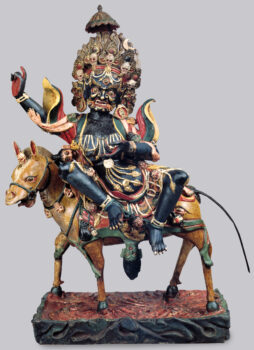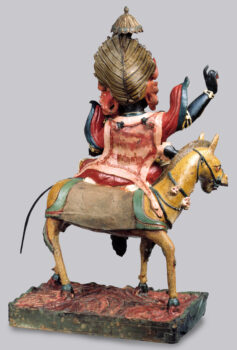Tibet or Mongolia
19th century


Tibet or Mongolia
19th century


Magzor Gyalmo, or the Queen that Repels Armies, is a specific form of the principal female protector deity of Tibet, Palden Lhamo.In contrast to metal objects, sculptures made from more malleable materials, such as clay and papier-mâché, are often lively, a character further enhanced by their colorful painting. This impressive image has mainly been carved from wood, but many minute details have been modeled using materials such as papier-mâché and leather, an additive technique that is a characteristic of Mongolian sculpture. Particularly remarkable details here include the use of gilding on the nose and cheeks to the wrathful expression of the face, the individualization of each head on the garland she wears, and the careful delineation of the hair on the mule she rides.
In Buddhism gender is considered more fluid compared to some other religions. Certain traditions emphasize the importance of all genders in achieving enlightenment. The feminine is considered an embodiment of wisdom and the masculine is an embodiment of method.
Buddhist practitioners in some traditions believe that cutting through ordinary perceptions that keep us in the endless cycle of death and rebirth, known as samsara, can create a powerful and enhanced divine identity that leads to enlightenment.
A meditation technique primarily used in tantric practice that involves imagining a deity in one’s mind or imagining oneself becoming a deity and carrying out various activities. Such techniques are intended to help a practitioner transform ordinary perception and achieve enlightened qualities.
Prescribed practices that carry symbolic meaning and value within a specific tradition and are intended to attain a desired outcome. Rituals are usually done as part of a ceremony or regular routine.
Protectors of Buddhist teachings who destroy obstacles that impede the path to enlightenment. The more frightening and gruesome their appearance, the greater their power.
Get the latest news and stories from the Rubin, plus occasional information on how to support our work.